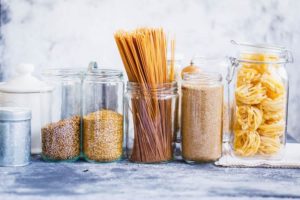How helpful is the food label in identifying fiber in foods?
The nutrition facts panel currently lists “dietary fiber” as a total of fibers in the food. It doesn’t differentiate between soluble and insoluble fibers. Also, current health claims define a food as a “good source” of fiber if it contains 2.5 grams of fiber per serving and an “excellent source” of fiber has to contain at least 5 grams of fiber per serving. The adequate intake of fiber for adult women is 25 grams per day and for men, 38 grams per day. Therefore, consumers shouldn’t think that because they eat a serving or two of foods that are “good” sources of fiber that they will be consuming enough fiber.
What is the difference between soluble and insoluble fibers?
Fiber is defined as the dietary material in foods that cannot be broken down in the gastro-intestinal tract. Insoluble fibers are the kind that used to be referred to as “roughage.” For example, when you eat a slice of whole wheat bread, the protein and carbohydrate are broken down in the stomach and small intestines as simple sugars and amino acids (the building blocks of protein) and get absorbed into the blood stream where they are delivered to different body tissues for fuel or repair. The fiber in the whole wheat bread doesn’t get broken down and passes through to the colon where it helps to bulk up the stool and contribute to regularity.
Soluble fibers are found in fruits and vegetables and help regulate blood sugar and cholesterol. We need both types of fibers and most foods have a bit of both types, but the insoluble fibers in grain foods contribute to regularity and to tackling the fiber shortage in most American’s diets.
Why should I choose fiber-rich foods over fiber supplements?
The simple answer is because fiber-rich foods provide more than just fiber; grains, fruits, vegetables, and beans also contain vitamins, minerals, and plant nutrients (called phytonutrients) needed for good health. Fiber supplements may also bind with some minerals, such as calcium, magnesium, and iron, so try to get fiber from foods, not supplements.
Are whole grains higher in fiber than other grains?
Not always; for example, bran cereal is one of the highest fiber cereals (think All Bran, Fiber One, or Bran Flakes). Yet bran cereals aren’t always whole grain cereals (a whole grain cereal contains all three parts of a grain: the outer bran layer, the inner endosperm, and the germ). On the other hand, some grains that sound like they are high in fiber might not be. Consider a bread labeled “multi-grain.” It might contain several grains, but none of them might be whole grains. So, be a savvy label reader and check the ingredient list and the grams of dietary fiber per serving.
Besides dietary fiber, what else can help with regularity?
Water intake is very important for regularity. In addition, some medications can cause constipation, such as pain medications. Therefore, in addition to consuming fiber-rich foods, drink plenty of water and consider if your medications might be affecting regularity.
Can you provide five tips to increase dietary fiber?
- Include a high fiber cereal with breakfast most days of the week. Mix the high fiber cereal with your favorite cereal and add some fruit, like berries or bananas, and chopped nuts to start the day with a fiber-packed, nutrient-rich meal.
- Invest in a scrub brush and brush veggies and fruits under running water instead of peeling them. Cooking potatoes or carrots with the peel can boost fiber and add a nice texture to items like, mashed potatoes, potato salad, or roasted carrots.
- Choose fiber-rich snacks: fresh veggies, nuts, or whole grain crackers with hummus.
- Try substituting some the flour in baked goods with whole wheat flour or give whole wheat pasta a try. Brown rice is another whole grain that is a tasty substitution for white rice.
- Baked beans, black beans, kidney beans, or edamame, are rich in fiber and can be used in a variety of dishes to boost fiber intake.

